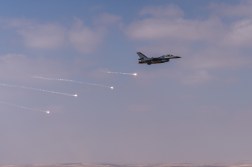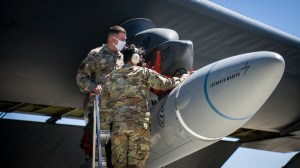Northrop Grumman opens new propulsion system factory in anticipation of boom in hypersonic missile production

Northrop Grumman has a new facility for building scramjets and other advanced air-breathing propulsion systems for the hypersonic missiles that the U.S. military is pursuing.
The company broke ground on the Hypersonics Capability Center (HCC) in Elkton, Maryland, two years ago, and the 60,000-square-foot facility is now officially open, the company announced on Thursday.
The contractor has been selected as a propulsion system supplier for multiple hypersonics programs featuring air-breathing engines, such as the Defense Advanced Research Projects Agency’s HAWC and the Air Force’s HACM.
“The HCC was really born as we look forward to air-breathing weapon systems and thinking through its needs. Air-breathing weapon systems are not fielded in scale today. They offer some unique design architecture that doesn’t have the backbone or the foundation that the solid-propulsion defense industrial base has to leverage as we think of building these in scale. And so our goal is really in the HCC was to think … about taking this capability for air-breathing propulsion from [research, development, test and evaluation] and transitioning into a production environment,” Chris Haynes, director for strategy and business development for Northrop Grumman’s missile products, told reporters during a teleconference on Thursday.
The Pentagon is keen on acquiring hypersonic weapons, which are designed to fly faster than Mach 5, be highly maneuverable and pose major challenges for enemy air defenses. The department has yet to field any, but it plans to ramp up procurement in the coming years and deploy them on a variety of platforms.
Unlike boost-glide systems that use rockets to achieve hypersonic speeds, scramjets pull in oxygen from the atmosphere and can add thrust or energy to their flight profile as they maneuver along their flight path. Scramjet-powered hypersonic cruise missiles are also expected to have a smaller form factor than boost-glide missiles — meaning more platforms can carry the weapons — and potentially be less expensive.
Vendors need to be able to deliver hypersonics that are affordable and reliable — and build the systems in large quantities, Haynes noted.
“That really starts at the earliest phases in RDT&E thinking through the design aspects of what we’re developing, and how we would transition that into a production environment so that we can deliver it at the price point that DOD seeks to buy these weapons at,” he said.
Undersecretary of Defense for Acquisition and Sustainment William LaPlante has said the Pentagon would like the average unit cost of hypersonics to be less than $10 million. That would still be a high price tag compared with most missiles in the U.S. military’s arsenal, but significantly less than the latest cost projections for some of the hypersonic weapons being pursued.
Northrop Grumman says the new manufacturing center will feature the most modern equipment and leverage digital engineering techniques.
“We’re really trying to drive the engineers working side by side with operations fully integrated on the floor so as we’re making design decisions, we understand the implications of those decisions as it relates to … delivering weapons that are reliable, affordable and at scale. So we tried to take a full lifecycle approach when we designed the layout of the HCC … really trying to think about not just the design and development but again the full production and integration elements,” Haynes said.
“And so our approach was to try to put as much of the capability under one roof trying to minimize part movement [around the country]. And so in simple terms, we think about raw material coming in one side of the building … and our goal is to produce an outcome of having air-breathing propulsion engines coming out the other side. And so that minimizing of part movement really helps us drive that rate and affordability piece that I spoke to, it really helps us deliver not only for the air-breathing propulsion needs for the current programs that we see moving, like HACM. But the facility was really designed not just to be a scramjet air-breathing propulsion center, but really ramjet” as well for future programs, he added.
DefenseScoop asked Haynes what the production capacity of the facility will be once propulsion systems move into full-rate production.
“It depends,” he said, “because air-breathing propulsion as a weapon system is not something that we see fielded in quantity today. There’s still much coalescing on that landscape. Design techniques for how we manufacture them will drive overall throughput and rate capability. So I can say that we’ve designed the facility with added square footage and footprint, recognizing that we [in the defense industrial base and DOD] may not have all the answers today … as we work through what is that balance on manufacturing approaches, how do we leverage advanced manufacturing techniques like additive manufacturing and others, while also drawing in conventional manufacturing techniques that may drive affordability.”
He added: “We’re designed well to be able to support the needs for the near-term systems that we see. And we’ve left ourselves with some room to grow as we develop together collaboratively within the industry base, as well as with DOD and our prime partner Raytheon in the instance of HACM. As we sharpen our knowledge about how we’re going to ultimately manufacture these things, that will drive kind of a sharper point on the throughput and total ready capability in the building.”
Ed Jones, senior manager for mission assurance at Northrop Grumman, told DefenseScoop and other reporters that the company has already invested “tens of millions” of dollars into the new facility and it’s bringing in additional personnel to work there.
“Right now, we are onboarding new staff within the area. We’re also pulling from other resources within [Northrop Grumman]. So it’s kind of a combination of approach right now” when it comes to finding workers, he said.
The building was designed for 50-plus workers once the systems go into full-rate production, according to Jones.
However, “not only is the space within the building modular, the building itself is modular and we all designed it with that in mind, having completed a lot of the site work. So as we continue to see the demand change or increase, we even have the ability to add square footage to the building in a rapid manner as well,” he added.






